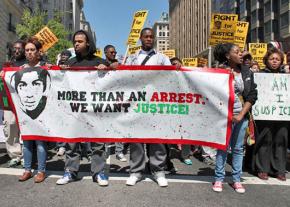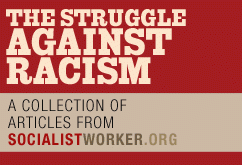Building a new movement for racial justice
The killer of Trayvon Martin may be behind bars, but the struggle to end the killing of African Americans by police and racists must continue to grow.
IT TOOK 45 days and a nationwide protest movement to force Florida authorities to arrest George Zimmerman, the vigilante who pulled the trigger and killed Trayvon Martin. But the social and political dynamics that led to Trayvon's murder remain--and we need to continue the longer-term struggle to overcome them.
The movement for justice for Trayvon has led to a long overdue examination of an ugly reality in 21st century America--the all-too-frequent killing of unarmed African Americans who were judged to be suspicious, sometimes by vigilantes like Zimmerman, but more often by police.
The cops inevitably claim they felt compelled to shoot because of some tragic mistake made under pressure--a cell phone or a wallet mistaken for a gun is a favored excuse. But the only justification Zimmerman could offer for pursuing and then confronting Trayvon Martin was that the 17-year-old was somewhere that Zimmerman didn't think he should be--and that he was Black.
Further, the police complicity with Zimmerman only underscored how cops view the shooting death of African American youths as something routine--to be covered up before any difficult questions get asked. From the kid-gloves treatment Zimmerman received when he was briefly taken into custody, to the destruction of forensic evidence important to any investigation, to their corroboration of Zimmerman's claim to be the victim, the police in Sanford, Fla., were all too ready to cover up for a racist murder.
The Sanford cops, of course, were taking their cues from their big-city counterparts--like the NYPD cops glorified on so many TV shows. These same cops blasted 41 shots at Amadou Diallo in 1999 when he reached for his wallet to show ID. They fired 50 bullets at Sean Bell because he was driving while Black in 2005. And earlier this year, they shot and killed 18-year-old Ramarley Graham in the bathroom of his home, as his grandmother and 6-year-old brother stood by.
If these atrocities represent racist police violence at its most horrific, the flip side is the routine abuse and harassment suffered by people of color as a result of the NYPD's "stop and frisk" policy, which views Blacks and Latinos as suspects by dint of the color of their skin. According to the Center for Constitutional Rights, of the 576,394 people stopped under the policy in 2009, some 84 percent were Black or Latino--in a city where those groups make up only about half the population.
If an entire section of the population is criminalized under accepted and perfectly legal law enforcement policies, should it come as any surprise that police are prepared to shoot first and ask questions later?
The NYPD racks up more killings of unarmed Blacks and Latinos than other police forces because of its quasi-military character, its size and its quantity of armaments. But police across the U.S. follow the same pattern.
Consider Bay Area Rapid Transit cop Johannes Mehserle, who shot to death Oscar Grant III on January 1, 2009 in Oakland, Calif. The killing was caught on cell phone video, and caused such widespread outrage and protest that Mehserle was actually charged with murder, unlike the vast majority of killer cops. In the end, however, Mehserle was convicted of a lesser charge of involuntary manslaughter, and thanks to lenient sentencing, he spent just one year behind bars for taking Oscar Grant's life.
However, police murder of African Americans is old news in Oakland. The city's police force has been under a monitor appointed by a federal judge since 2003 because of persistent corruption and violence.
A typical example: Police officer Hector Jimenez shot and killed an unarmed African American man, Mack "Jody" Woodfox, in 2008. The case was so egregious that Jimenez was fired--but an arbitrator returned him to the force in 2011 with back pay.
Police targeting of people of color isn't confined to cities with large concentrations of African Americans. In Seattle, where Blacks comprise about 10 percent of the population, the Feds have also stepped in because of rampant racial profiling and police targeting of people of color. According to the U.S. Department of Justice:
When SPD officers use force, they do so in an unconstitutional manner nearly 20 percent of the time; SPD officers too quickly resort to the use of impact weapons, such as batons and flashlights. When SPD officers use batons, 57 percent of the time it is either unnecessary or excessive.
The Feds specifically said that Seattle cops didn't engage in "discriminatory policing, but the investigation raised serious concerns that some of SPD's policies and practices, particularly those related to pedestrian encounters, could result in unlawful discriminatory policing." In other words, Seattle cops harass a lot of pedestrians--many of whom just happen to be Black or brown--or, in the case of John Williams, shot to death by a Seattle cop in August 2010, a member of the Nuu-Chah-Nulth First Nations in British Columbia.
BUT SOMETHING more fundamental is at play than police who are directed to harass people of color on the street.
As author Michelle Alexander has argued, the targeting of African Americans by law enforcement is result of a political shift in the late 1960s, when politicians crafted a "law and order" rhetoric as a surrogate for the old racist language of the Jim Crow segregation era.
And it wasn't just Republicans pushing these policies: the $30 billion crime bill signed into law by Bill Clinton in 1994 expanded the "war on drugs" initiated under Clinton's Republican predecessors, adding new federal penalties and enforcement. According to the Justice Policy Institute, "the Clinton administration's 'tough on crime' policies resulted in the largest increases in federal and state prison inmates of any president in American history."
The result of all this is an incarceration rate in the U.S. that is unknown to the rest oif the industrialized world. And with it comes the disenfranchisement of those convicted of felonies--disproportionately African American men. This "new Jim Crow," as Alexander calls it, in turn legitimizes racist attitudes--not just in law enforcement and the judicial system, but throughout society. She writes:
In "colorblind" America, criminals are the new whipping boys. They are entitled to no respect and little moral concern. Like the 'coloreds' in the years following emancipation, criminals today are deemed characterless and purposeless people, deserving of our collective scorn and contempt.
That's where people like George Zimmerman come in. In a country increasingly polarized by class inequality, social tensions are inevitable. The unstated but pervasive idea that "Black" equals "criminal," along with vast institutional racism, inevitably channels those tensions toward racial violence.
This is especially the case with the paranoid mentality found in the suburban, gated communities of the sort where Zimmerman lived. As Rich Benjamin, an African American man who lived in gated communities for two years and authored a book on the topic, wrote in the New York Times:
Residents' palpable satisfaction with their communities' virtue and their evident readiness to trumpet alarm at any given "threat" create a peculiar atmosphere--an unholy alliance of smugness and insecurity. In this us-versus-them mental landscape, them refers to new immigrants, Blacks, young people, renters, non-property-owners and people perceived to be poor.
These semi-fortified gated communities represent a political base of the U.S. right--and they are central to the pro-Zimmerman camp that has taken shape among right-wing media, conservative politicians and open racists like the Nazi group patrolling the streets of Sanford.
If it seems like a stretch to link the fascist right with the views expressed on Fox News, take a closer look at what blogger Frank Wiles, writing for the Independent, called the "blurry line" between the conservative media and the extreme right. For example, when Fox News contributor Michelle Malkin posted an alleged photo of Trayvon Martin flashing gang signs, the image--which turned out not to be Trayvon at all--had first appeared on the Nazi website Stormfront.
THE RIGHT'S despicable campaign to smear Trayvon comes after the mainstreaming of racist ideas in the Republican presidential primaries, where Newt Gingrinch made anti-Black tirades a key part of his campaign. Gingrich called President Barack Obama the "food stamp president" and suggested that school kids be employed in schools as janitors to teach them the "value of work."
Rick Santorum took the same tack, stating, "I don't want to make black people's lives better by giving them somebody else's money; I want to give them the opportunity to go out and earn the money."
With this kind of racism now acceptable in U.S. political discourse, it should come as no surprise that individuals like Zimmerman are prepared to act on the same assumptions.
And now that targeting African Americans through racial profiling and mass incarceration has been institutionalized as the "new Jim Crow," the political groundwork has been laid for "Juan Crow"--legislation that mandates racial profiling and detention of Latinos suspected of being undocumented immigrants. This year's commemoration of the 1965 civil rights march in Selma, Ala., rightly drew the connections between the civil rights struggles of the past and the fight for immigration rights today.
The widespread, grassroots response to the murder of Trayvon Martin has raised the prospect of a new anti-racist movement.
Since the peak of the civil rights and Black Power movements in the 1960s and '70s, African American politics has been dominated by Black Democratic officials. Yet it's now clearer than ever that the election of African Americans to office--including the White House--has done nothing to curb violence against Blacks by police or Zimmerman types prepared to take the law into their own hands.
What's needed is a long-term struggle against institutional racism--challenging not only in the criminal justice system, but discrimination in education, housing and employment.
Taking a stand against police violence is a crucial first step. By demanding justice and accountability when African Americans are brutalized--or worse--by police in our cities and communities, we can begin to bring together the activists who will form the core of a new movement for racial justice. Public meetings with victims of police racism--or their surviving family members--can keep the spotlight on cases that are routinely ignored by the mainstream media. Pickets, protests and campus speakouts can keep up the pressure--and have an impact, as the arrest of George Zimmerman makes clear.
There's no way to predict when and how a new anti-racist movement will take shape. But the elements are in place: a criminal justice system that continues to incarcerate African Americans on a mass scale; police who act as judge, jury and executioner in the streets; and now, thousands of activists across the U.S. who decided to take a stand for Trayvon Martin.
The struggle to win racial justice has a long history, and it has never been an easy one. But the murder of Trayvon Martin may well be the spark that ignites that movement once again.




